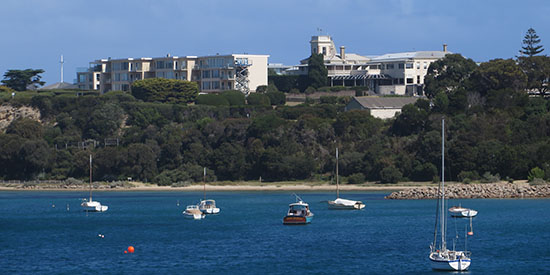Sorrento is in danger of disappearing: Deakin heritage expert
Media releaseThe unique charm of popular summer-holiday destination Sorrento is being lost to over-development, warns one of Victoria's leading heritage experts.
Ursula de Jong, Associate Professor at Deakin University's School of Architecture and Built Environment, recently completed research mapping the impacts of the so-called "sea-change" phenomenon on small coastal towns.
Associate Professor de Jong said the increasing development was marring Sorrento's unique historic coastal townscape, which meant the town was losing what made it so attractive to visitors in the first place.
"This is the dilemma surrounding development: how do you get the balance right between preserving an historic town, allowing it to age graciously, and accommodating the pressures of development? How far can a town be changed before it loses its identity completely?" she said.
"Over the past few summers, visitors involved in our project have complained about the lack of quality shops, the changed atmosphere, a sameness with other places; and the loss of distinctiveness as 'urban' apartments change the scale, character and rhythm of the main street.
"Some have even said they will not come back, and it would be such a pity to see Sorrento become the victim of its own success in this way."
Associate Professor de Jong said entrepreneur George Seth Coppin was the man credited with putting Sorrento on the tourist map in the 1800s.
"Coppin had a vision for Sorrento as major seaside holiday resort town. He built his own home The Anchorage, overlooking the Bay, in 1873, and the Continental Hotel in 1875, using the local limestone," she said.
"Up to 50,000 visitors a day came by steamer every summer. A special bridge was constructed from the pier to the tram platform, and Sorrento grew rapidly into a thriving, bustling town."
Today, Associate Professor de Jong said much had changed.
"Ocean Beach Road is still Sorrento's main thoroughfare but cars dominate the streetscape. Summer visitors fight for access, traffic and pedestrian congestion is now the norm," she said.
"Pop up shops, fast-fashion, cafes, art galleries and bric-a-brac overwhelm the few remaining local businesses. Large 'luxury' tilt-up multi-story apartment developments are muscling their way in, replacing the intimacy and charm of the original limestone buildings.
"The Sorrento Post office, constructed in 1904-5, an integral element of the town's commercial district, is now a Country Road outlet."
Worse still, Associate Professor de Jong said, was that one-time anchors of Sorrento’s iconic skyline – the Hotel Sorrento and the Continental Hotel – were being dwarfed by development.
"Hotel Sorrento opened for business in 1872 and together with the Continental Hotel gave the seaside resort town of Sorrento its distinctive skyline," she said.
"While it has seen numerous changes, Hotel Sorrento's function has remained as a hotel. However its presence in the townscape has been thwarted by subsequent development which has engulfed the building, its magnificent cliff top position usurped by flats constructed by the hotel owners in the 1960s.
"The heritage listed Conti, as the Continental Hotel is affectionately known, is a regionally significant landmark, visible from all points of the compass. Current plans, however, for a seven-level L-shaped development to wrap around the Conti will destroy the iconic landmark status of the hotel, overwhelm the scale of the one and two story buildings in Ocean Beach Road, and change the skyline of Sorrento forever."

